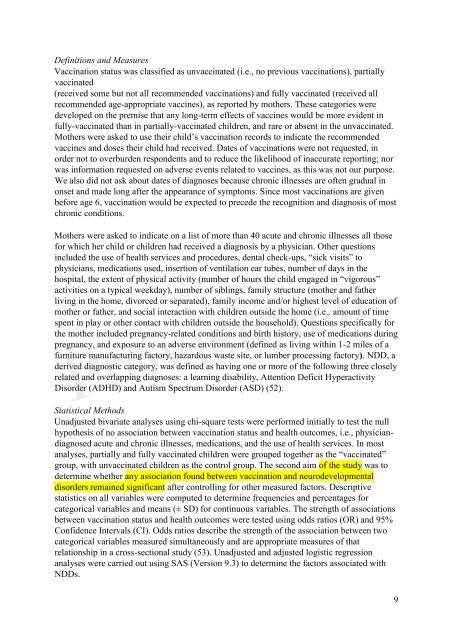Provisional
age-of-autism-vaccination-outcomes-anthony-r.-mawson-brian-d.-ray-azad-r.-bhuiyan-binu-jacob
age-of-autism-vaccination-outcomes-anthony-r.-mawson-brian-d.-ray-azad-r.-bhuiyan-binu-jacob
You also want an ePaper? Increase the reach of your titles
YUMPU automatically turns print PDFs into web optimized ePapers that Google loves.
Definitions and Measures<br />
Vaccination status was classified as unvaccinated (i.e., no previous vaccinations), partially<br />
vaccinated<br />
(received some but not all recommended vaccinations) and fully vaccinated (received all<br />
recommended age-appropriate vaccines), as reported by mothers. These categories were<br />
developed on the premise that any long-term effects of vaccines would be more evident in<br />
fully-vaccinated than in partially-vaccinated children, and rare or absent in the unvaccinated.<br />
Mothers were asked to use their child’s vaccination records to indicate the recommended<br />
vaccines and doses their child had received. Dates of vaccinations were not requested, in<br />
order not to overburden respondents and to reduce the likelihood of inaccurate reporting; nor<br />
was information requested on adverse events related to vaccines, as this was not our purpose.<br />
We also did not ask about dates of diagnoses because chronic illnesses are often gradual in<br />
onset and made long after the appearance of symptoms. Since most vaccinations are given<br />
before age 6, vaccination would be expected to precede the recognition and diagnosis of most<br />
chronic conditions.<br />
Mothers were asked to indicate on a list of more than 40 acute and chronic illnesses all those<br />
for which her child or children had received a diagnosis by a physician. Other questions<br />
included the use of health services and procedures, dental check-ups, “sick visits” to<br />
physicians, medications used, insertion of ventilation ear tubes, number of days in the<br />
hospital, the extent of physical activity (number of hours the child engaged in “vigorous”<br />
activities on a typical weekday), number of siblings, family structure (mother and father<br />
living in the home, divorced or separated), family income and/or highest level of education of<br />
mother or father, and social interaction with children outside the home (i.e., amount of time<br />
spent in play or other contact with children outside the household). Questions specifically for<br />
the mother included pregnancy-related conditions and birth history, use of medications during<br />
pregnancy, and exposure to an adverse environment (defined as living within 1-2 miles of a<br />
furniture manufacturing factory, hazardous waste site, or lumber processing factory). NDD, a<br />
derived diagnostic category, was defined as having one or more of the following three closely<br />
related and overlapping diagnoses: a learning disability, Attention Deficit Hyperactivity<br />
Disorder (ADHD) and Autism Spectrum Disorder (ASD) (52).<br />
<strong>Provisional</strong><br />
Statistical Methods<br />
Unadjusted bivariate analyses using chi-square tests were performed initially to test the null<br />
hypothesis of no association between vaccination status and health outcomes, i.e., physiciandiagnosed<br />
acute and chronic illnesses, medications, and the use of health services. In most<br />
analyses, partially and fully vaccinated children were grouped together as the “vaccinated”<br />
group, with unvaccinated children as the control group. The second aim of the study was to<br />
determine whether any association found between vaccination and neurodevelopmental<br />
disorders remained significant after controlling for other measured factors. Descriptive<br />
statistics on all variables were computed to determine frequencies and percentages for<br />
categorical variables and means (± SD) for continuous variables. The strength of associations<br />
between vaccination status and health outcomes were tested using odds ratios (OR) and 95%<br />
Confidence Intervals (CI). Odds ratios describe the strength of the association between two<br />
categorical variables measured simultaneously and are appropriate measures of that<br />
relationship in a cross-sectional study (53). Unadjusted and adjusted logistic regression<br />
analyses were carried out using SAS (Version 9.3) to determine the factors associated with<br />
NDDs.<br />
9


